#Duke Friedrich Ferdinand of Schleswig-Holstein
Text

Friedrich Ferdinand, Duke of Schleswig-Holstein and his wife Duchess Karoline Mathilde, mids 1900s.
#duke friedrich ferdinand of schleswig-holstein#duchess karoline mathilde of schleswig-holstein#schleswig-holstein#schleswig-holstein-sonderburg-glücksburg#german royal#german royalty#1900s#mids 1900s#1905
15 notes
·
View notes
Photo

Princess Karoline Mathilde of Schleswig-Holstein-Sonderburg-Augustenburg married Friedrich Ferdinand, the eldest son of Friedrich, Duke of Schleswig-Holstein-Sonderburg-Glücksburg and Princess Adelheid of Schaumburg-Lippe. Karoline Mathilde's elder sister, Augusta Viktoria was German Empress and Queen of Prussia as the wife of Wilhelm II, German Emperor.
2 notes
·
View notes
Photo

Princess Helena Adelaide of Schleswig-Holstein-Sonderburg-Glücksburg (1 June 1888 - 30 June 1962) was the third eldest daughter of Friedrich Ferdinand, Duke of Schleswig-Holstein and his wife Princess Karoline Mathilde of Schleswig-Holstein-Sonderburg-Augustenburg. She was a princess of Denmark through her marriage within the House of Schleswig-Holstein-Sonderburg-Glücksburg to Prince Harald of Denmark. Princess Helena was a Nazi sympathiser during World War II and was after the war exiled from Denmark, but eventually allowed to return, where she died.
#Princess Helena Adelaide of Schleswig-Holstein-Sonderburg-Glücksburg#House Glucksburg#XIX century#XX century#people#portrait#photo#photography#Black and White
1 note
·
View note
Photo

Those that have married in to Royal Families since 1800
Monaco
Ernst August, Prince of Hanover, Duke of Brunswick and Lüneburg (Ernst August Albert Paul Otto Rupprecht Oskar Berthold Friedrich-Ferdinand Christian-Ludwig Prinz von Hannover Herzog zu Braunschweig und Lüneburg Königlicher Prinz von Großbritannien und Irland) born 26 February 1954
Ernst August was born in Hanover, the eldest son of Ernst August, Hereditary Prince of Brunswick and his first wife, Princess Ortrud of Schleswig-Holstein-Sonderburg-Glücksburg
As the senior male-line descendant of George III of the United Kingdom, Ernst August is head of the House of Hanover, the surviving junior branch of the medieval House of Welf, which itself is the older branch of the House of Este, a dynasty whose earliest known members lived in Lombardy in the late 9th/early 10th century and which, in its younger branch, ruled Ferrara (1240–1597) and the Duchy of Modena-Reggio (1288–1796) in Italy.
The title of Prince of Great Britain and Ireland was recognised ad personam for Ernst August's father and his father's siblings by King George V of the United Kingdom on 17 June 1914. The hereditary Dukedom of Cumberland and Teviotdale and the Earldom of Armagh, borne in 1917 by his paternal great-grandfather, were suspended under the Titles Deprivation Act 1917. However, the title Royal Prince of Great Britain and Ireland had been entered into the family's German passports, together with the German titles, in 1914. After the German Revolution of 1918–19, with the abolishment of nobility's privileges, titles officially became parts of the last name. So, curiously, the British prince's title is still part of the family's last name in their German passports, while it is no longer mentioned in their British documents.
On 29 August 1931, Ernst August's grandfather Ernest Augustus, Duke of Brunswick, as head of the House of Hanover, declared the formal resumption, for himself and his dynastic descendants, of use of his former British princely title as a secondary title of pretense, which style, "Royal Prince of Great Britain and Ireland", his grandson Ernst August continues to claim. As heir of the last Duke of Cumberland and Teviotdale and Earl of Armagh, Ernst August has the right to petition under the Titles Deprivation Act 1917 for the restoration of his ancestors' suspended British peerages, but he has not done so. His father, also called Ernst August, did, however, successfully claim British nationality after World War II by virtue of a hitherto overlooked (and since repealed) provision of the Sophia Naturalization Act 1705 (Attorney-General v HRH Prince Ernest Augustus of Hanover [1957] 1 All ER 49). However, a problem arose as foreign royal titles can't be entered into a British passport. Therefore, the titles Prince of Hanover, Duke of Brunswick and Lüneburg could not be mentioned there, nor could the British titles due to the Titles Deprivation Act of 1917. The name which was finally entered into his father's British documents, was thus Ernest Augustus Guelph, with the addition of His Royal Highness. Guelph is thus also the British last name of Ernst August and accordingly of his siblings and children, all styled Royal Highnesses in the United Kingdom.
Ernst August is also a great-grandson of the last German emperor, Emperor Wilhelm II. His father's sister was Frederica of Hanover, sometime queen consort of the Hellenes, and he is thus a first cousin of both ex-King Constantine II and his sister, Queen Sophia, whose husband Juan Carlos I abdicated his throne in favour of their son, Felipe VI of Spain in 2014. Ernst August's uncle, Prince George William of Hanover, married Princess Sophie of Greece and Denmark, a sister of the future royal consort Prince Philip, Duke of Edinburgh, evoking in 1946 the only known case of a British monarch, George VI, withholding requested permission for a kinsman's marriage under the Royal Marriages Act 1772 (on the advice of his Government as a result of World War II's hostilities). It was held by British officials at the time that the marriage and its issue would not be legitimate in the United Kingdom despite being legal in Germany.
By a 24 August 1981 declaration issued by his father as the Head of House, pursuant to Chapter 3, §§ 3 and 5 of the House laws of 1836, Ernst August was authorised to marry dynastically, and did firstly marry, civilly on 28 August 1981 and religiously on 30 August 1981, Chantal Hochuli, the daughter and heiress of a Swiss real estate developer. They had two sons: Prince Ernst August Andreas Philipp Constantin Maximilian Rolf Stephan Ludwig Rudolph (born 19 July 1983) Prince Christian Heinrich Clemens Paul Frank Peter Welf Wilhelm-Ernst Friedrich Franz (born 1 June 1985) Ernst August and Chantal Hochuli divorced on 23 October 1997.
He married secondly, civilly in Monaco on 23 January 1999, Princess Caroline of Monaco, who was at the time expecting the birth of their child: Princess Alexandra Charlotte Ulrike Maryam Virginia (born 20 July 1999)
As he was born in the male line of George II of Great Britain, he sought permission to marry pursuant to the British Royal Marriages Act 1772, which would not be repealed until the Succession to the Crown Act 2013 took effect on 26 March 2015. On 11 January 1999, Queen Elizabeth II issued a Declaration in Council, "My Lords, I do hereby declare My Consent to a Contract of Matrimony between His Royal Highness Prince Ernst August Albert of Hanover, Duke of Brunswick-Luneburg and Her Serene Highness Princess Caroline Louise Marguerite of Monaco..." Without the Royal Assent, the marriage would have been void in Britain where Ernst August's family owns property and his lawful descendants remain in succession to both the British crown and the two suspended peerages. Similarly the Monégasque court officially notified the government of France of Caroline's marriage to Ernst August, receiving assurance that there was no objection in compliance with the (since defunct) Franco-Monegasque Treaty of 1918. Moreover, in order for Caroline to retain her claim to the throne of Monaco and to transmit succession rights to future offspring, the couple were also obliged to obtain the approval of yet a third nation, in the form of official consent to the marriage of Caroline's father, Prince Rainier III as the sovereign of Monaco.
Nonetheless, Caroline was a Roman Catholic and Ernst August the heir male of George III when the couple wed, at which time a provision of the Act of Settlement 1701 stipulated that in the event the British crown is to devolve upon an heir married to "a Papist", that heir is permanently disabled from succeeding to the throne, which would pass instead to the next Protestant in the order of succession who had not been married to a Roman Catholic. The Succession to the Crown Act 2013 repealed that marital restriction (also embodied in the Bill of Rights 1689), with retroactive effect, as of 26 March 2015.
Ernst August's younger brother Prince Ludwig Rudolph of Hanover and his wife, Princess Isabella of Hanover (1962–1988), died tragically. On 28 November 1988, while authorities removed Princess Isabella's body from The Queen's Villa in Gmunden, Austria, a house owned by Ernst August which he had left to his brother and sister-in-law, and investigated the drug strewn scene, Ludwig Rudolph, distraught over his wife's apparently accidental cocaine overdose, placed a call to his brother in London, imploring him to take care of the couple's 10-month-old son. Then he fled. Hours later Ludwig Rudolph was found dead, apparently a victim of suicide, near his family's hunting lodge several miles away, on Lake Traun.Custody of their infant son Otto Heinrich was eventually awarded, contrary to the expressed wishes of Ludwig Rudolph as the surviving parent and Ernst August's legal efforts, to the child's maternal grandparents, Count Ariprand and Countess Maria von Thurn und Valsassina-Como-Vercelli, to be raised at their family seat, Bleiburg Castle in southern Austria.
After their marriage, Ernst August and Caroline moved to Le Mée-sur-Seine, France, where they had purchased an 18th-century manor house from their friend Karl Lagerfeld. Their daughter went to kindergarten and prep-school there, while the family used Caroline's house in Monte Carlo and Ernst August's hunting lodge near Gmunden, Austria, as secondary homes. In September 2009 it was reported in the French and English press that Ernst August has been living separately from his wife Caroline, who had returned to Monaco while he moved to Austria. The manor house in France was subsequently sold, just as had been Hurlingham Lodge in London, after the divorce from his first wife.
He was photographed urinating on the Turkish Pavilion at the Expo 2000 event in Hanover, causing a diplomatic incident and a complaint from the Turkish embassy accusing him of insulting the Turkish people. He successfully sued those who published (Bild-Zeitung) the photograph for invasion of privacy, obtaining an award of 9,900 euros, although the paper had previously published a photo of Ernst August urinating outside a hospital in Austria.
In 2004, he was convicted of aggravated assault and causing grievous bodily harm after supposedly beating a man with a knuckleduster. He has demanded a retrial for the case on the basis of false evidence. His lawyers have publicly stated that he has never owned a knuckleduster in his life nor held one in his hand.
In 2004, Ernst August had signed over his German property to his elder son, including Marienburg Castle, the agricultural estate of Calenberg Castle, the "Princely House" at Herrenhausen Gardens in Hanover and some forests near Blankenburg Castle (Harz) which he had re-purchased in former East Germany after the German reunification of 1990. At the time, Ernst-August’s wealth was estimated as high as $250 million. Since then, the younger Ernst August has taken over many representative tasks on behalf of his father. The latter remained in charge of the Austrian family assets.
In 2013 however, Ernst August was removed from the chairmanship of a family foundation based in Liechtenstein which holds the properties near Gmunden in Austria, the Hanovers' main residence in exile after 1866 when their Kingdom of Hanover was annexed by Prussia. Instead, the younger Ernst August was put in charge, reportedly for negligence on part of his father, at the initiative of the foundation's trustee Prince Michael of Liechtenstein. The foundation manages vast forests, a game park, a hunting lodge, the Queen's Villa and other property. In 2017 Ernst August filed legal action to recover his chairmanship, and he intends to revoke the bestowal of his German property. Due to this dispute over family assets, he also declared his intention to withhold consent for his son's marriage to Ekaterina Malysheva which he did not attend.
On Monday, 3 April 2005, Ernst August was admitted to hospital with acute pancreatitis. The next day, he fell into a deep coma, two days before the death of his father-in-law, Rainier III, Prince of Monaco. On Friday, 8 April 2005, hospital officials reported that he was no longer in a coma but remained in intensive care. A report the same day on BBC World described his condition as "serious but not irreversible." On 9 April 2005, according to a report on BBC, a hospital spokesman reported that Ernst August was receiving "permanent medical care." After his release he was subsequently seen in public with his wife. In an interview he admitted at the time that his health crisis was caused by his hyperactive lifestyle and problems with alcohol
4 notes
·
View notes
Text
Heir apparent
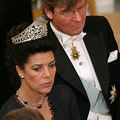
Then she met Ernst August von Hanover, one of the names her mother had found in the Almanack de Gotha and the next best thing to Prince Charles. For had Britain been subject to Salic law in which as a rule women cannot inherit, Ernst rather than the Windsors would now be on the British throne instead of Queen Victoria’s descendants.
Ernst August was born in Hanover, the eldest son of Ernst August, Hereditary Prince of Brunswick (1914–1987) and his first wife, Princess Ortrud of Schleswig-Holstein-Sonderburg-Glücksburg (1925–1980).
Prince of Hanover, Duke of Brunswick and Lüneburg (Ernst August Albert Paul Otto Rupprecht Oskar Berthold Friedrich-Ferdinand Christian-Ludwig Prinz von Hannover Herzog zu Braunschweig und Lüneburg, born in 26 February 1954 is head of the deposed royal House of Hanover which held the thrones of the former Kingdom of Hanover until 1866. German royalty, he married Princess Caroline of Hanover on January 23, 1999. He is a descendant of England's King George III and the son of Ernst August IV, Prince of Hanover and his first wife Princess Ortrud of Schleswig-Holstein-Sonderburg-Glücksburg.
0 notes
Text

Family of Queen Victoria's niece, Duchess Adelaide of Schleswig-Holstein née Hohenlohe-Langenburg (1835-1900) in 1888.
Back row: Duke Friedrich Ferdinand of Schleswig-Holstein and Prince Christian of Schleswig-Holstein.
Middle row: Princess Louise Sophie of Schleswig-Holstein, Duke Ernst Günther of Schleswig-Holstein, German Empress Augusta Victoria, Prince Adalbert of Prussia, Duchess Karoline Mathilde of Schleswig-Holstein, Princess Feodora of Schleswig-Holstein and Prince Christian Victor of Schleswig-Holstein.
Front row: Prince Eitel Friedrich of Prussia, Crown Prince Wihelm of Prussia and Duchess Adelaide of Schleswig-Holstein.
I only mentioned those Royals that i could recognize.
Duchess Adelaide of Schleswig-Holstein née Hohenlohe-Langenburg was the second born daughter of Ernst I, Prince of Hohenlohe-Langenburg by his wife Princess Feodora of Leiningen who was the older, maternal half-sister of the British Queen Victoria.
Prince Christian of Schleswig-Holstein was a younger brother of Frederick VIII, Duke of Schleswig-Holstein who was the husband of Duchess Adelaide and father of German Empress Augusta Victoria. Christian was married to Queen Victoria's daughter, Princess Helena.
Source: Villa Feodora
#duchess adelaide of Schleswig-Holstein-Sonderburg-Augustenburg#princess adelaide of Hohenlohe-Langenburg#princess Augusta Victoria of Schleswig-Holstein-Sonderburg-Augustenburg#prince Christian of Schleswig-Holstein#prince Christian Victor of Schleswig-Holstein#princess karoline Mathilde of Schleswig-Holstein-Sonderburg-Augustenburg#Duchess Karoline Mathilde of Schleswig-Holstein#princess louise Sophie of Schleswig-Holstein-Sonderburg-Augustenburg#princess louise Sophie of Schleswig-Holstein#Crown Prince Wihelm of prussia#prince eitel friedrich of prussia#prince Adalbert of Prussia#Duke Friedrich Ferdinand of Schleswig-Holstein#princess feodora of Schleswig-Holstein-Sonderburg-Augustenburg#princess Feodora of Schleswig-Holstein#duke ernst gunther of Schleswig-Holstein#Duke ernst Gunther of Schleswig-Holstein-Sonderburg-Augustenburg#Schleswig-Holstein#Hohenlohe-Langenburg#prussia#german royal#german royalty#1888#late 1880s#1880s#Duchess Karoline Mathilde of Schleswig-holstein-sonderburg-glücksburg#Duke Friedrich Ferdinand of schleswig-holstein-sonderburg-glücksburg#Schleswig-Holstein-Sonderburg-Augustenburg#Schleswig-holstein-sonderburg-glücksburg#german empress augusta victoria
33 notes
·
View notes
Text

Coburg-Schleswig-Holstein family gathering in 1930.
Back row: Friedrich (3rd Prince of Solms-Baruth), Prince Harald of Denmark, Count Hans of Solms-Baruth, Hereditary Prince Johann Leopold of Saxe-Coburg and Gotha, Princess Sibylla of Saxe-Coburg and Gotha, Prince Hubertus of Saxe-Coburg and Gotha, Princess Caroline-Mathilde of Denmark, Princess Caroline Mathilde of Saxe-Coburg and Gotha, Hereditary Prince Hans Albrecht of Schleswig-Holstein and Prince Wilhelm Friedrich (Duke of Schleswig-Holstein).
Front row: Princess Karoline Mathilde (Countess Hans of Solms-Baruth), Princess Marie Melita (Duchess of Schleswig-Holstein), Tsar Ferdinand I of Bulgaria, Princess Victoria Adelaide (Duchess of Saxe-Coburg and Gotha), Prince Charles Edward ( Duke of Saxe-Coburg and Gotha), Princess Helena Adelaide (Princess Harald of Denmark), Prince Friedrich Josias of Saxe-Coburg and Gotha, Princess Adelaide Louise (Princess of Solms-Baruth).
#duke charles edward of saxe-coburg and gotha#duchess victoria adelaide of saxe-coburg and gotha#duke wilhelm friedrich of schleswig-holstein-sonderburg-glücksburg#duchess marie melita of schleswig-holstein-sonderburg-glücksburg#prince harald of denmark#princess harald of denmark#count hans of solms-baruth#countess hans of solms-baruth#friedrich 3rd prince of solms-baruth#princess friedrich of solms-baruth#tsar ferdinand i of bulgaria#hereditary prince johann leopold of saxe-coburg and gotha#princess caroline-mathilde of denmark#prince hubertus of saxe-coburg and gotha#princess caroline mathilde of saxe-coburg and gotha#hereditary prince hans albrecht of schleswig-holstein-sonderburg-glücksburg#prince friedrich josias of saxe-coburg and gotha#saxe-coburg and gotha#schleswig-holstein-sonderburg-glücksburg#german royalty#german royal#1930s#1930
26 notes
·
View notes
Text
Royal Wedding on 25 November 1925 in Langenburg.
Prince Karl of Leiningen (27) and Grand Duchess Maria Kirillovna of Russia (18).

The bridegroom was the third child and second born son of Emich, 5th Prince of Leiningen and his wife Princess Feodora of Hohenlohe-Langenburg. His eldest brother, Emich Ernst, Hereditary Prince of Leiningen, died at the age of twenty-one in 1918. So, Prince Karl became his father's heir.
Both of his parents were related to Queen Victoria.
The bride was the eldest child of Grand Duke Kirill Vladimirovich and his wife Princess Victoria Melita of Saxe-Coburg and Gotha. Her mother was previously married to Ernest Louis, Grand Duke of Hesse and by Rhine and had a child by her first marriage, Princess Elisabeth of Hesse and by Rhine who sadly died of virulent tiphoid fever in 1903.
The dashing bride wearing her maternal grandmother's wedding dress.




The wedding ceremony

The bride and her first cousin Princess Irma of Hohenlohe-Langenburg.

The wedding guests

Back row: Prince Hermann of Leiningen, Princess Marie Melita of Schleswig-Holstein, Princess Elizabeth of Greece and Denmark, Grand Duke Dmitri Pavlovich, Princess Marina of Greece and Denmark, Prince Gottfried of Hohenlohe-Langenburg, unknown man, Infanta Beatrice Duchess of Galliera, unknown man and Infante Alfonso Duke of Galliera.
Middle row: Duke Charles Edward of Saxe-Coburg and Gotha, unknown woman, Prince Ernst II of Hohenlohe-Langenburg, Princess Consort Alexandra of Hohenlohe-Langenburg, Heinrich XLV, Hereditary Prince Reuss Younger Line, Prince Hesso of Leiningen, Emich 5th Prince of Leiningen, Duchess Marie Antoinette of Mecklenburg-Schwerin, Princess Viktoria Countess of Solms-Rödelheim and Assenheim and unknown people.
Front row: Princess Caroline Mathilde of Saxe-Coburg and Gotha, Tsar Ferdinand I of Bulgaria, Princess Alexandra of Hohenlohe-Langenburg, Grand Duchess Victoria Feodorovna, Grand Duke Vladimir Kirillovich, Grand Duchess Kira Kirillovna, Princess Irma of Hohenlohe-Langenburg, Princess Feodora of Leiningen, Prince Friedrich Josias of Saxe-Coburg and Gotha, Princess Nicholas of Greece and Denmark, Duchess Victoria Adelaide of Saxe-Coburg and Gotha, Princess Sibylla of Saxe-Coburg and Gotha, Grand Duke Kirill Vladimirovich and Grand Duchess Elisabeth of Oldenburg.
Some royal guests

Back row: Princess Alexandra of Hohenlohe-Langenburg, Princess Irma of Hohenlohe-Langenburg, Grand Duchess Kira Kirillovna and Princess Sibylla of Saxe-Coburg and Gotha.
Front row: Grand Duke Vladimir Kirillovich and Prince Friedrich Josias of Saxe-Coburg and Gotha.
#karl 6th prince of leiningen#grand duchess maria kirillovna#grand duchess maria kirillovna of russia#grand duke kirill vladimirovich#grand duchess victoria feodorovna#emich 5th prince of leiningen#princess feodora of leiningen#duke charles edward of saxe-coburg and gotha#duchess victoria adelaide of saxe-coburg and gotha#princess nicholas of greece and denmark#infanta beatrice duchess of galliera#infante alfonso duke of galliera#prince ernst ii of hohenlohe-langenburg#princess consort alexandra of hohenlohe-langenburg#tsar ferdinand i of bulgaria#grand duke dmitri pavlovich#duchess marie melita of schleswig-holstein#prince hesso of leiningen#prince hermann of leiningen#princess viktoria of leiningen#grand duchess kira kirillovna#grand duke vladimir kirillovich#princess sibylla of saxe-coburg and gotha#princess caroline mathilde of saxe-coburg and gotha#prince friedrich josias of saxe-coburg and gotha#princess alexandra of hohenlohe-langenburg#prince gottfried of hohenlohe-langenburg#princess irma of hohenlohe-langenburg#royal weddings#grand duchess elisabeth alexandrine of oldenburg
75 notes
·
View notes
Text
Royal Wedding on 5 February 1916 at Coburg.
Prince Wilhelm Friedrich of Schleswig-Holstein-Sonderburg-Glücksburg (25) and Princess Marie Melita of Hohenlohe-Langenburg (17).

The bridegroom was the only son of Friedrich Ferdinand, Duke of Schleswig-Holstein and his wife Princess Karoline Mathilde of Schleswig-Holstein-Sonderburg-Augustenburg. His oldes sister was married to Charles Edward, Duke of Saxe-Coburg and Gotha who was a first cousin of his mother-in-law, the Princess Consort of Hohenlohe-Langenburg.
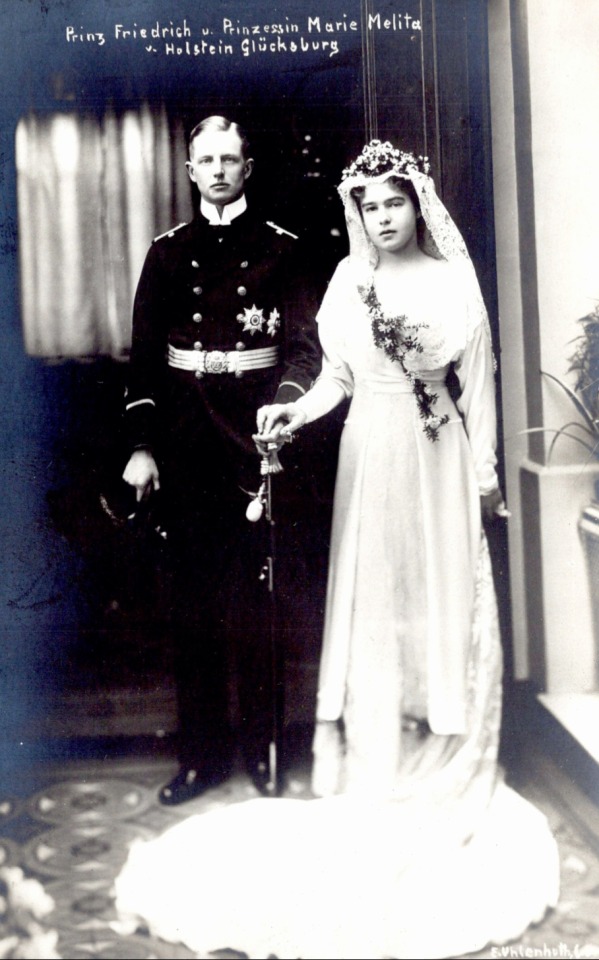
The bride was the second child and eldest born daughter of Ernst II, Prince of Hohenlohe-Langenburg and his wife Princess Alexandra of Saxe-Coburg and Gotha.
The bridegroom's mother and the bride's father were first cousins. Their mutual grandmother was Queen Victoria's half-sister.

The bride and her siblings, Prince Gottfried, Princess Alexandra and Princess Irma.
Marie Melita was the first granddaughter of Grand Duchess Maria Alexandrovna to marry, also young like her mother and maternal aunts.
#prince wilhelm friedrich of schleswig-holstein-sonderburg-glücksburg#princess marie melita of hohenlohe-langenburg#prince gottfried of hohenlohe-langenburg#princess alexandra of hohenlohe-langenburg#princess irma of hohenlohe-langenburg#royal weddings#1916#1910s#schleswig-holstein-sonderburg-glücksburg#schleswig-holstein#duke wilhelm friedrich of schleswig-holstein-sonderburg-glücksburg#duke wilhelm friedrich of schleswig-holstein
36 notes
·
View notes
Text
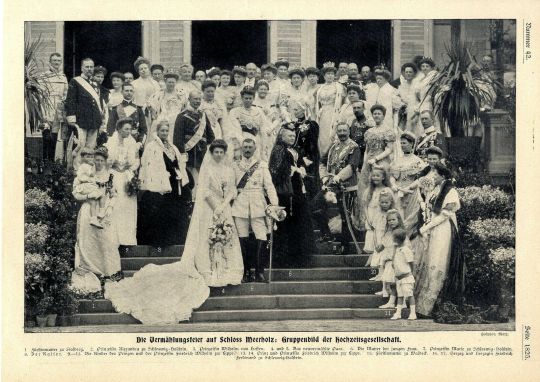
Royal Wedding at Meerholz Castle, group photo, 1906.
The bridegroom was Prince Albert Christian of Schleswig-Holstein-Sonderburg-Glücksburg (1863-1948) who was a nephew of King Christian IX of Denmark and therefore first cousin to Alexandra, Queen Consort of the United Kingdom.
The bride was Countess Ortrud of Ysenburg and Büdingen (1879-1918).
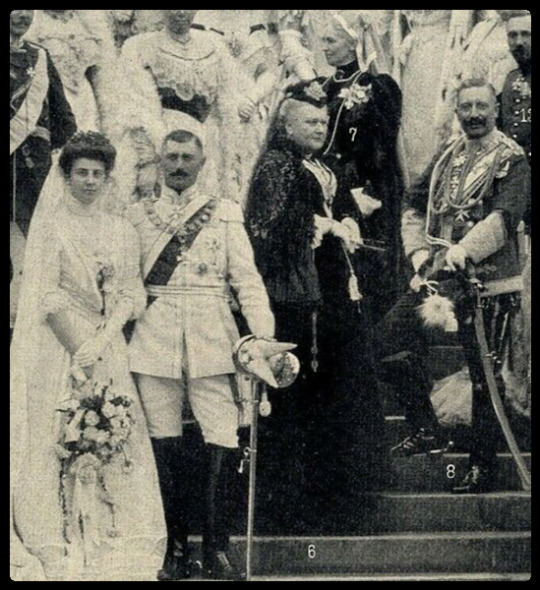
Kaiser Wilhelm II as a special royal guest at the wedding of his wife's relative. Augusta Victoria's brother-in-law Friedrich Ferdinand, Duke of Schleswig-Holstein was the eldest brother of Albert Christian.

The bride and bridegroom leaving the church.

The couple had four children. Sadly Ortrud died in 1918. After Ortrud's death, he married Princess Hertha of Ysenburg and Büdingen on September 19, 1920 in Büdingen . Their only daughter was Princess Ortrud of Schleswig-Holstein (1925–1980) who married Kaiser Wilhelm's grandson Hereditary Prince Ernest Augustus of Hanover. Their son Ernest Augustus, Prince of Hanover is married to Princess Caroline of Monaco.
#Prince Albert Christian of Schleswig-Holstein-Sonderburg-Glücksburg#Countess Ortrud of Ysenburg and Büdingen#schleswig-holstein-sonderburg-glücksburg#royal wedding#kaiser wilhelm ii#1906#1900s#mids 1900s
46 notes
·
View notes
Text
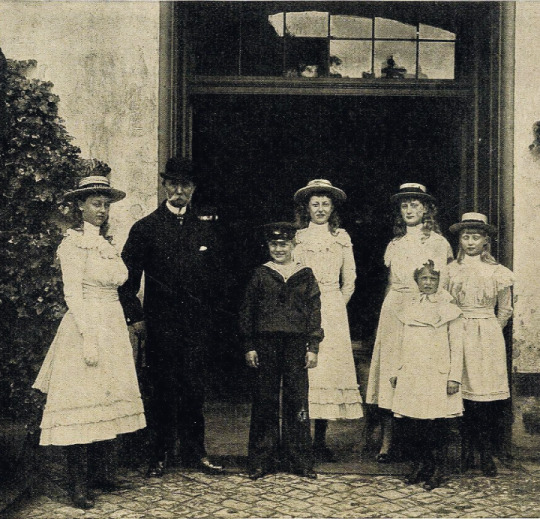
Prince Julius of Schleswig-Holstein-Sonderburg-Glücksburg (1824-1903) with the children of his nephew Friedrich Ferdinand, Duke of Schleswig-Holstein. 1901.
From left to right: Princess Alexandra Victoria (1887-1957), Duke Friedrich Wilhelm (1891-1965), Princess Victoria Adelaide (1885-1970), Princess Helena Adelaide (1888-1962), Princess Adelaide (1889-1964) and Princess Caroline-Mathilde (1894-1972).
Prince Julius was the eighth of the ten children of Friedrich Wilhelm, Duke of Schleswig-Holstein-Sonderburg-Glücksburg and Princess Louise Caroline of Hesse-Kassel.
Danish King Christian IX was his elder brother.
Source: ebay
#prince julius of Schleswig-Holstein-Sonderburg-Glücksburg#princess Victoria Adelaide of Schleswig-Holstein-Sonderburg-Glücksburg#princess Alexandra Victoria of Schleswig-Holstein-Sonderburg-Glücksburg#princess Helena Adelaide of Schleswig-Holstein-Sonderburg-Glücksburg#princess Adelaide of Schleswig-Holstein-Sonderburg-Glücksburg#Duke Friedrich Wilhelm of Schleswig-Holstein-Sonderburg-Glücksburg#Schleswig-Holstein-Sonderburg-Glücksburg#Schleswig-Holstein#german romanticism#german royal#german royalty#1901#early 1900s#princess karoline mathilde of schleswig-holstein-sonderburg-glücksburg
39 notes
·
View notes
Text
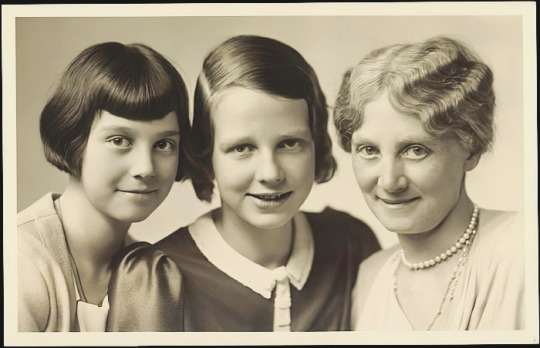
Grand Duchess Alexandra of Mecklenburg-Schwerin (1882-1963) with her daughters Duchess Anastasia (1923-1979) and Duchess Thyra (1919-1981). 1930s.
Both girls were named after their grandmothers.
Alexandra's eldest daughter, Duchess Olga, born in 1916 died in 1917 in unknown circumstances.
Their father was Grand Duke Frederick Francis IV of Mecklenburg-Schwerin, son of Grand Duke Frederick Francis III and Grand Duchess Anastasia Mikhailovna.
Thyra (the eldest) was blonde and tall like her paternal aunts, Queen Alexandrine of Denmark and Crown Princess Cecilie of Mecklenburg-Schwerin, she resembled her father. She didn't marry or have children.
Anastasia was brunette and looked like her mother. She married Prince Friedrich Ferdinand of Schleswig-Holstein (relative) in 1943. The couple had four daughters.
#Grand Duchess Alexandra of Mecklenburg-Schwerin#duchess thyra of Mecklenburg-Schwerin#duchess Anastasia of Mecklenburg-Schwerin#princess alexandra of hanover and cumberland#princess alexandra of hanover#Hanover#Hanover and Cumberland#Mecklenburg-Schwerin#german royal#german royalty#1930s
22 notes
·
View notes
Photo
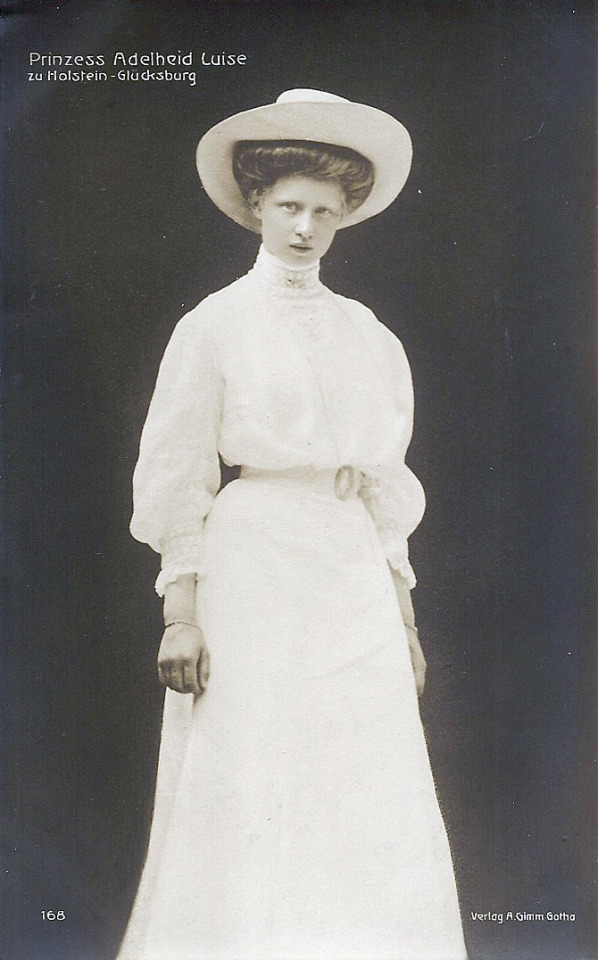
Princess Adelaide Louise of Schleswig-Holstein-Sonderburg-Glücksburg (19 October 1889 – 11 June 1964) was a daughter of Friedrich Ferdinand, Duke of Schleswig-Holstein and his wife Princess Karoline Mathilde of Schleswig-Holstein-Sonderburg-Augustenburg.
She was the Princess consort of Solms-Baruth through her marriage to Friedrich, 3rd Prince of Solms-Baruth.
#Adelaide of Schleswig-Holstein-Sonderburg-Glücksburg#House Glucksburg#XIX century#XX century#people#portrait#photo#photograpy#Black and White
0 notes